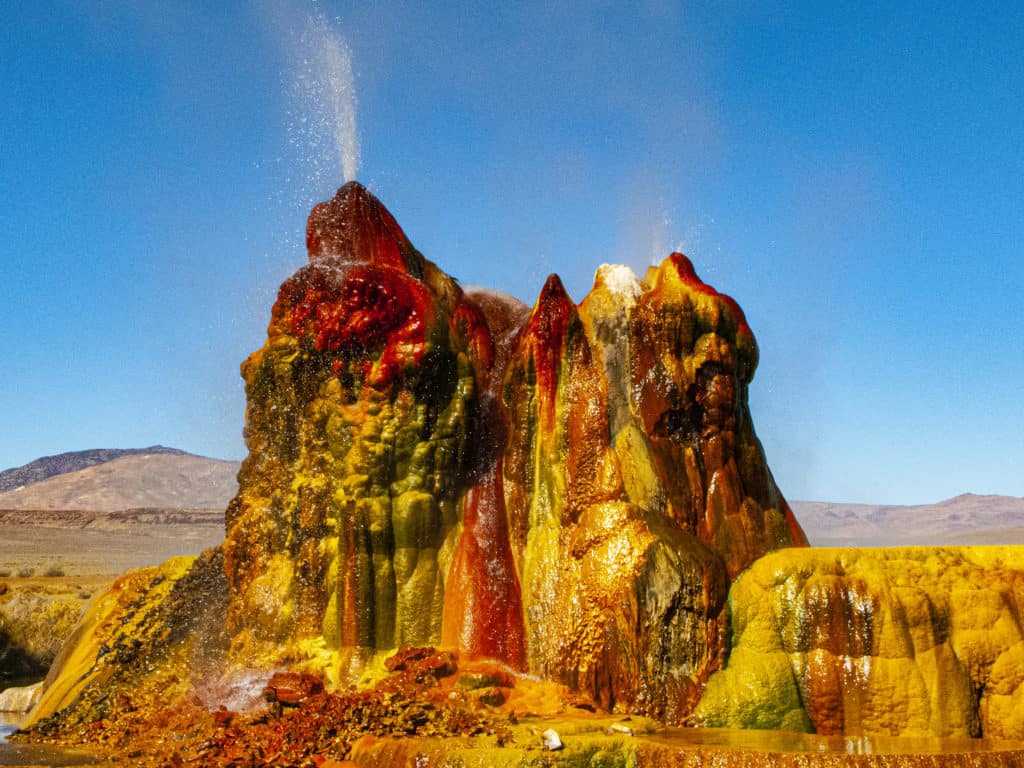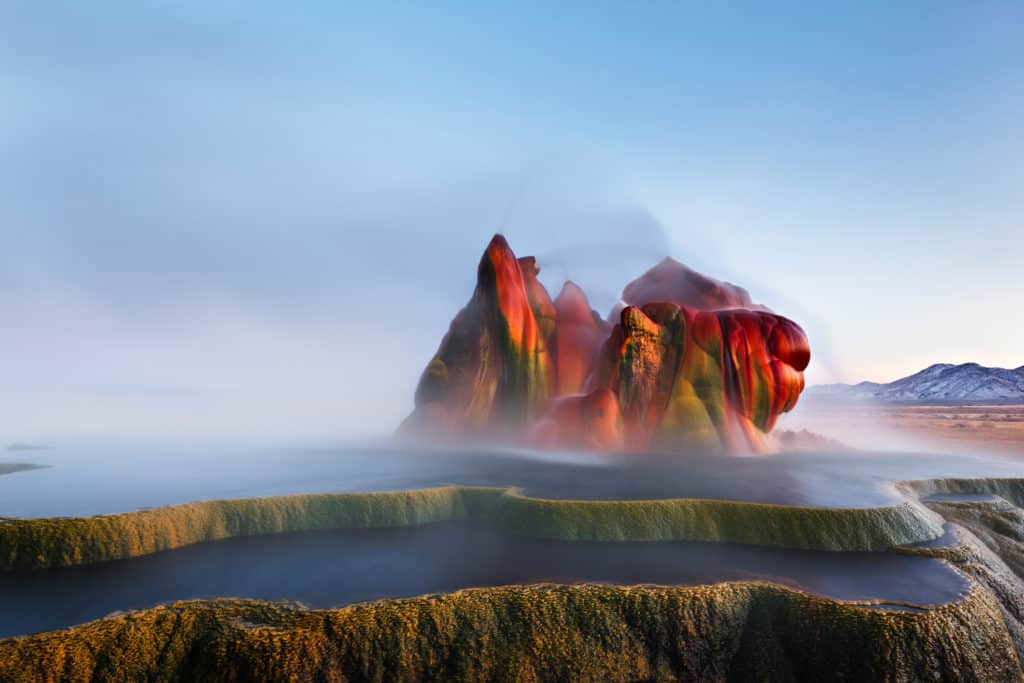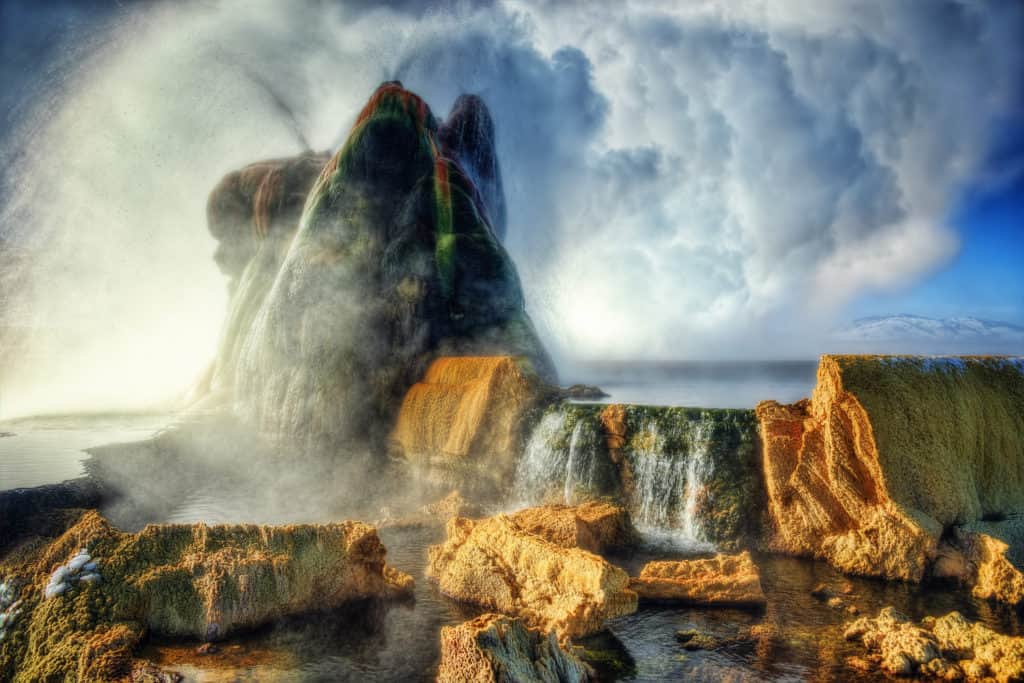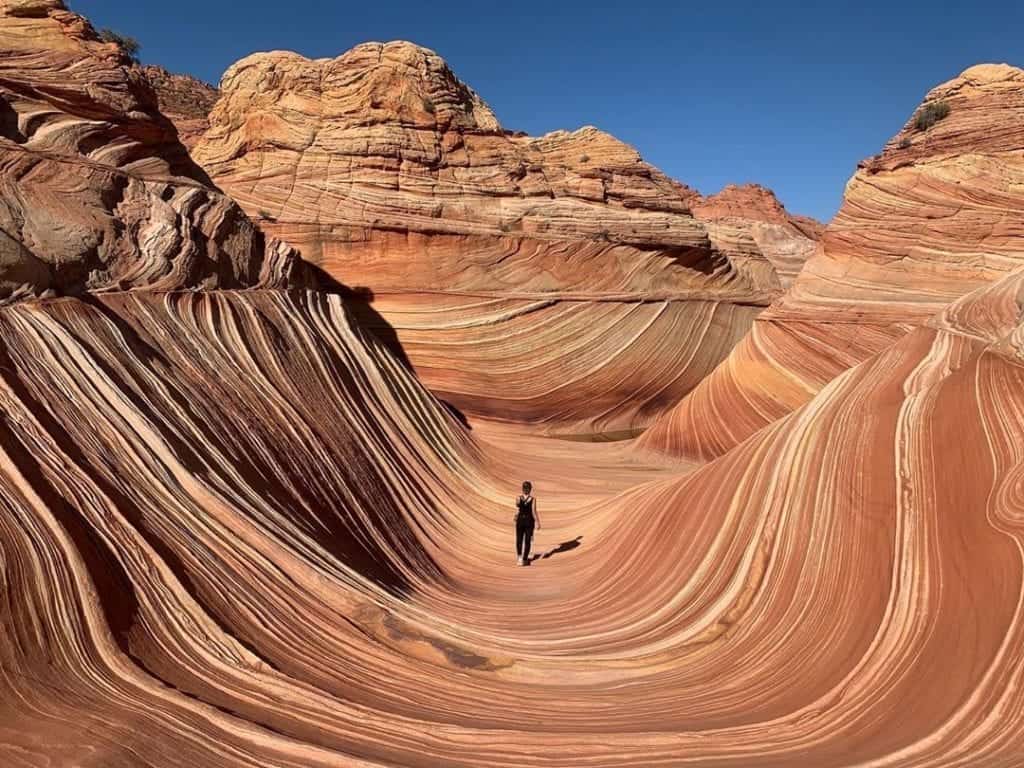Most of the stunning geological wonders we travel to see are the products of natural forces. Some of those forces wield their powers slowly, like glaciers, rains and floods. Others, like volcanoes and earthquakes, alter landscapes suddenly. But every once in a while, a mind-blowing marvel of nature arises in the landscape because of an accidental action taken by one or more people. Such is the case with Fly Geyser, located on 3,800-acre Fly Ranch in the middle of the Black Rock Desert in northern Nevada, about two hours north of Reno. Fly Geyser is the result of perhaps one of the happiest accidents imaginable because human error led to the creation of a geothermal treasure.
Though Fly Geyser isn’t known to many, hasn’t been viewed by many people and isn’t easy to access — a ticketed tour is required for an immersive view — it couldn’t be more worth your time and effort to see it.

How on Earth Did Fly Geyser and a Duo of Other Geysers Form?
At Fly Ranch, several columns of boiling water shoot up into the air through large mounds so strikingly colorful, it’s hard to believe they’re not part of an art installation — especially given the fact that the land is owned by the Burning Man Project, an organization that works to extend the culture of the annual world-famous Burning Man event, a “temporary metropolis dedicated to community, art, self-expression and self-reliance” that’s created entirely by event participants. About 70,000 people typically shape the pop-up city (aka Black Rock City) in the week preceding and encompassing Labor Day weekend in late August.
Geysers are a rare phenomenon because their formation requires hydrogeological conditions that only exist in a few places on the planet. Typically, geysers are also quite old — with most having been formed several thousand years ago. However, Fly Geyser and two other geysers at the site are quite young and resulted from human interventions — unintended tapping of geothermal sources.
The formation of the first of the three geysers started in 1916, and it only came about because some residents decided to drill a well for farming irrigation purposes. It didn’t take long for the drillers to give up on the project though: the water they discovered turned out to be a shockingly hot 200 °F. But the hole they created provided an opening for the boiling underground water to spew and deposit enough calcium carbonate to form a 12-foot-tall cone. Enter the geyser known as The Wizard.
That opening was followed by the creation of a second one at the site, which came about in a similar way — as the unintended result of a 1964 test drilling project conducted by a geothermal power company that ended up deeming the water they reached too cool to meet their energy objectives. After making that determination, they reportedly sealed the hole, but it didn’t hold. Scalding water began spouting out, depositing dissolved minerals that formed multiple, ever-growing cones (they’re presently about 6 feet tall) atop a 25 to 30-foot-high mound, as well as several travertine terraces with around 30 to 40 pools at its base. This is geyser #2, aka the amazing Fly Geyser, located several hundred feet north of The Wizard, which ceased being active after the underground pressure was released by Fly Geyser.
A third geyser at the site, called Will’s Geyser, was discovered in 2006, but it was most likely born of natural forces and sports a volcano-like shape that shoots water upward as high as five feet and grows at a rate of about six inches per year.

What Fly Geyser Looks Like Today
Imagine towering red-and-green mounds rising out of a terraced, pool-filled landscape; endless spouts of water; fields of reeds and grasses stretching out beyond them; and dark peaks looming in the distance. The towering mounds’ bold, algae-produced hues contrast sharply with the neutral tones of the desolate playa wilderness and desert mountains, shaping a vista that’s both beautiful and otherworldly.
But it’s not just Fly Geyser’s appearance that’s extraordinary. Fly Geyser is truly like no other geyser out there — the 200 °F temperature and high amount of silica in the spouting water has caused quartz to form inside at super speed. It typically takes up to 10,000 years for quartz inside a geyser to form, but Fly Geyser has only been around for 57 years!
How to See Fly Geyser

Fly Ranch is located about 20 miles north of tiny Gerlach, Nevada, the gateway town to Burning Man and a common stop for visitors traveling to the event on the Burner Byway via State Route 34. It’s possible to get a distant view of Fly Geyser from the side of the road; the spouts of water are visible from many miles away because of the playa’s flatness.
Getting an up-close view, however, is an altogether different matter since Fly Geyser is located on privately-owned land that’s closed to the public. The good news is Friends of Nevada Black Rock High Rock, an organization dedicated to the conservation of the Black Rock Desert-High Rock Canyon Emigrant Trail National Conservation Area, has partnered with Burning Man Project to offer docent-guided nature walks of Fly Ranch from May-September. Reserve your spot for a three-hour walk (the cost of the ticket is donation-based) to get an immersive experience of Fly Geyser and the other two geysers on the property, as well as the opportunity to explore and connect with the Ranch’s broader geothermic environment. You’ll cover approximately two miles and learn a great deal about the flora, fauna, natural resources and history of the greater Black Rock Desert area.
The Future of Fly Ranch
In 2020, the Burning Man Project launched the Land Art Generator Initiative (LAGI 2020) design challenge, inviting people to propose, build and scale infrastructure at Fly Ranch that supports environmental sustainability solutions. The organization’s goal is to rally the ingenuity of the Burning Man community and, over a three-year period, enable Fly Ranch to become a year-round platform for the huge talent that creators bring to bear on the fleeting Burning Man event.
Come see Fly Geyser and the landscape that surrounds it before it becomes a permanent home for Burning Man’s presently temporary, pop-up city. Once that transformation happens, the area will still be astonishing, no doubt, but in a very different sort of way. This unique development will also likely mean that many, many more visitors will flow into desert lands that are currently near-empty.
Read next: Hiking The Wave — One of the Most Astounding Places You’ll Ever See. One of the hardest places to get a hiking permit is also one of the most beautiful.

